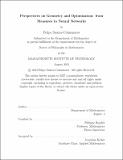| dc.contributor.advisor | Rigollet, Philippe | |
| dc.contributor.author | Suárez Colmenares, Felipe | |
| dc.date.accessioned | 2023-11-02T20:19:39Z | |
| dc.date.available | 2023-11-02T20:19:39Z | |
| dc.date.issued | 2023-09 | |
| dc.date.submitted | 2023-09-11T19:35:48.217Z | |
| dc.identifier.uri | https://hdl.handle.net/1721.1/152831 | |
| dc.description.abstract | This thesis explores geometrical aspects of matrix completion, interior point methods, unbalanced optimal transport, and neural network training. We use these examples to illustrate four ways in which geometry plays key yet fundamentally different roles in optimization.
The first part explores the benign properties of exploiting the intrinsic symmetries in matrix completion. In the second problem, we study the emergence of Fisher-Rao flows in entropic linear programs and explore its relationship to interior point methods. The third problem concerns unbalanced optimal transport. Inspired by a Lagrangian formulation of curvature for curves of measures, we present an algorithm for interpolation in Wasserstein-Fisher-Rao space. Lastly, we study the non-convex dynamics of neural network training for large step sizes and show that a simplified model of a two-layer neural network exhibits a phase transition and a self-stabilizing property known as the "edge of stability". | |
| dc.publisher | Massachusetts Institute of Technology | |
| dc.rights | In Copyright - Educational Use Permitted | |
| dc.rights | Copyright retained by author(s) | |
| dc.rights.uri | https://rightsstatements.org/page/InC-EDU/1.0/ | |
| dc.title | Perspectives on Geometry and Optimization: from Measures to Neural Networks | |
| dc.type | Thesis | |
| dc.description.degree | Ph.D. | |
| dc.contributor.department | Massachusetts Institute of Technology. Department of Mathematics | |
| mit.thesis.degree | Doctoral | |
| thesis.degree.name | Doctor of Philosophy | |
